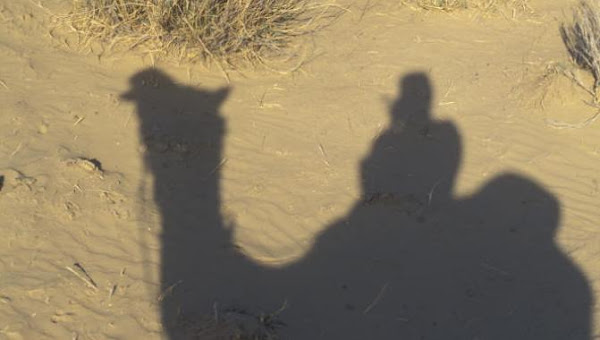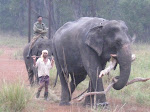It's in coffee table books, on news and on television. Actually it's everywhere. However, nothing is more enchanting than being present for earths largest religious gathering of pilgrims - the Kumbh Mela celebrated once every three years among four different locations, alongside famous river banks of the Indian plains. I arrived at Haridwar located on the banks of the River Ganga and entry point from which the river leaves the Himalayas to join the plains, with much apprehension and not knowing how the occasion would unfurl. Little did I realise the pomp and custom, as well as tradition associated with Kumbh Mela in Haridwar would not alter my feelings for humanity, instead it would increase my empathy, tolerance and respect for cultures and religions in a more humane way. One of life’s ambition of visiting the Maha Kumbh was finally fulfilled.
 According to astrologers, the 'Kumbh Fair' takes place when the planet Jupiter enters Aquarius and the Sun enters Aries. Kumbha (Kumbha means pot) Mela (means fair) is a sacred Hindu pilgrimage. It is said that a holy dip in sacred rivers during Maha Kumbh or Ardh Kumbh takes a human out of the circle of life & death. This explains the reason why over ten million pilgrims gather from the middle of January to end of April 2010, considered auspicious months to take part in sacred rituals.
According to astrologers, the 'Kumbh Fair' takes place when the planet Jupiter enters Aquarius and the Sun enters Aries. Kumbha (Kumbha means pot) Mela (means fair) is a sacred Hindu pilgrimage. It is said that a holy dip in sacred rivers during Maha Kumbh or Ardh Kumbh takes a human out of the circle of life & death. This explains the reason why over ten million pilgrims gather from the middle of January to end of April 2010, considered auspicious months to take part in sacred rituals. As far as the eye could there were tents everywhere. Except for a huge patch of green which represents the Rajaji National Park, the dust coated plains were covered with temporary accommodation shelters to cater to pilgrims who came walking, by rickshaws, public transport buses, private coaches, tractors and even on horseback. Then there were the sadhus, fakirs, mendicants - some of whom were semi nude, while the nagas were completely disrobed and smeared in ash.
On our first evening we attended the arati (fire lighting) ceremony at Parmarth Ashram situated on the river banks and overlooking the river ganga, looking resplendent in the evening light.In the words of Swami Chidanand Saraswatiji Maharaj, `the essence of the aarti ceremony is that all day long God offers us light - the light of the sun, the light of life, the light of His (Her) blessings. Aarti is a time when we say "thank you," and we offer back the light of our thanks, the light of our love and the light of our devotion. We realize that the small flame is nothing compared to the divine light which shines on us all day. Aarti is a ceremony of humility.' The rapid flow of gurgling waters had a mesmerising effect on my senses, the hum of the crowd and chanting of Vedic hymns by devotees and priests added to the effect. We waited for the religious head of the ashram to arrive, the crowds slowly began to fill in empty spaces, now few and rare. I heard my cellphone beep, it was an sms from a dear friend who informed me that his mother had passed away. I replied back saying that she would find heavenly peace. My being in a sublime setting probably prompted me to send out this soothing message.
Swami Chidanand, the head of the ashram arrived followed by his customary band of followers, many of whom were Westerners with tonsured heads. I couldn't single out nationalities but assumed they were from North America. He took over the microphone and started chanting in a powerful voice that had all sit back in silence. Dressed in a saffron robe, his long flowing hair and beard did nothing to conceal his eyes, full of humility; and seeming to show concern and understanding for one and all. The chanting reached a crescendo after which he showered his blessings on one and all. We trudged back to our vehicle truly inspired by events of the day, beginning with a memorable ride from the higher reaches of the Garhwal mountains in Pauri to the plains of Rishikesh. The ride had all the embellishments of a modern day movie thriller as we crossed high mountain passes, drove past verdant fields, and watched the serpentine river down below. At times it seemed so close we could touch the Alakananda river, minutes later it resembled a crooked line.
The sight of the confluence at Deoprayag was breathtaking, two rivers emerging from two different sources to form the river Ganga - the mother of all rivers and source of life to the plains of India. Fifty kilometers from Rishikesh we spotted the first river rafting camp - a cluster of small tents erected on sandy beaches alongside the river. Considered a haven for difficult and mild rapids, this stretch is a rafters paradise. As we neared Rishikesh, a stream of rubber inflated rafting boats came to view. Traffic and chaos on streets increased as well. We had arrived.
Early next morning we commenced our tour, this occasion it was the twin city of Haridwar. Filled with legends and stories dating back to time, Haridwar has its share of ashrams, yoga centers, sacred temples and bathing steps. Legend has it that the Saptarishi Ashram had seven sacred saints meditating at a particular spot. In order they not be disturbed River Ganga divided itself into seven streams around them. We found the tranquil ashram in the shade of mango trees and later surmised having seven streams made things easier for millions of pilgrims wanting to take a holy dip. There is no need to congregate at one stream.
We followed it up by a cable car ride top to the Chanda Devi Temple, the constant throng of pilgrims, our constant companions. Besides having a ten second glimpse of the idol of Chanda Devi installed by Adi Shankaracharya in the 8th century, we had a fascinating birds eye view of Haridwar down below, enveloped in a cloud of haze and dust. We finally headed for the camp of the naked Naga Sadhus.
The naga sadhus are all housed in a separate enclosure with each group having its own tented accommodation. Entry is restricted to all but a few for security reasons and also to ensure tempers are not raised and to prevent conflicts. Reclusive by nature, they live in their own private camps located in different parts of India, on mountains or in ashrams. Their interaction with the public is mainly restricted to participating at religious gatherings like the Kumbh Mela, where they are normally given the first right to bath in the Ganga on auspicious days during the Kumbh Mela.
Non shaven, their hair tied in matted locks, and body smeared with ash, we had a rare opportunity of interacting with them. Conversation, though was hard to come by, since most seemed reclusive and lost in their own cosmic spaces. A few smoked hashish which is basically done to curb sexual desires and to concentrate on meditation. Others stared back at us in mock silence. A couple of them wanted us to buy some handbags for the princely sum of five thousand rupees. We politely declined. One sadhu had his right lifted high above his head, the story goes he has been doing it for over forty years. It seems he disobeyed his teacher for which he was punished. His right arm seemed terribly weak due to loss of circulation, yet he had calmness written all over his face. There was also an amazing sight of a sadhu whose matted hair touched the ground when he stood up. It was all of six feet long, while he was a little over five feet tall. We walked passed sniffer dogs and patrolling guards back into the narrow lanes of Haridwar.
Yet another fascinating day was coming to an end, the sight of pilgrims bathing in the crystal clear river under the umbrage of the setting sun seemed to somehow suggest that for the inconsistencies life has to offer, faith brings all together. The largest gathering of pilgrims on Planet Earth for a religious event just proved a point.








No comments:
Post a Comment